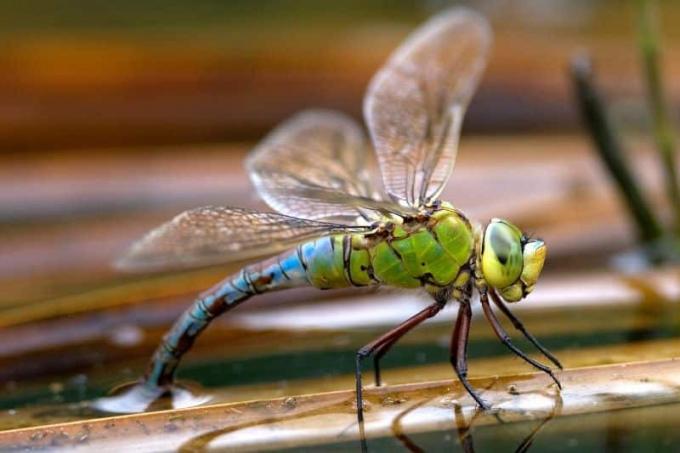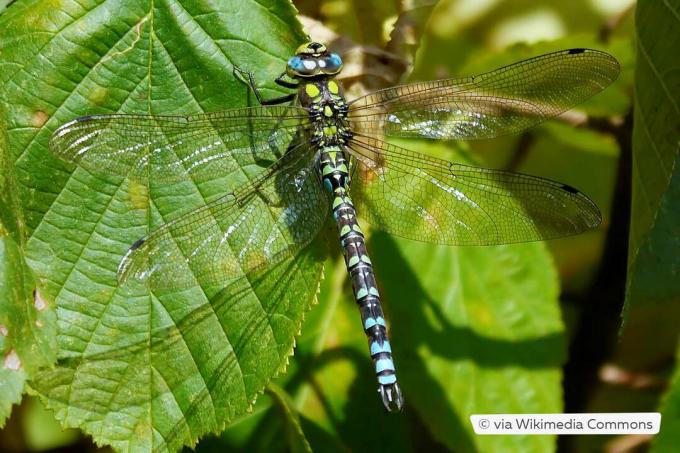
Unique body shape, dazzling colors - dragonflies fascinate like no other insect. But an encounter triggers not only amazement but also concern. Can they possibly sting, bite or spray poison? We clarify how dangerous dragonflies are for us.
In a nutshell
- Dragonflies have no sting and no venom glands
- their teeth are harmless to humans
- Bites are rare, feels like pinching
- Dragonflies are under protection
- do not hunt, injure or kill
Table of contents
- Dragonflies cannot sting
- Dragonflies cannot bite
- Dragonflies are not poisonous
- Dragonflies are protected
- Frequently Asked Question
Dragonflies cannot sting
The abdomen of a dragonfly is very long in relation to the rest of the body, tapers and therefore looks dangerous. The first association at this sight: sting! In view of the size, it is also assumed that a sting must hurt far more than that of bees and insects wasp stings the case is. And they are known to be very painful. But all this is just head cinema, the reality is completely harmless.

- Dragonfly has no sting in the traditional sense
- At the end of the abdomen is a so-called ovipositor
- this “sting” is blunt
- used only for laying eggs
A notice: Only females have this ovipositor, which they use to “drill” their eggs into plants or dead wood.
Dragonflies cannot bite
If a dragonfly sting isn't dangerous, what about a bite? Odonata, as dragonflies are scientifically called, actually have powerful jaws. Seen up close, they also look terrifying. However, only insects such as flies need to be afraid, mosquitoes, butterflies or beetles, all of which are on the dragonfly's diet.

Humans are not at risk for two reasons:
- Human skin is far too thick for the dragonfly's mandibles.
- Dragonflies rarely try to bite humans.
A notice: It is only when a dragonfly is caught and held in the closed hand that it can bite trying to escape. However, this feels more like a slight pinch and will only be felt for the duration of the "bite".
Dragonflies are not poisonous

Source: Andreas Eichler, 2012.09.22.-41-1-Kreith-Blue-green mermaid male, Edited from Plantopedia, CC BY-SA 3.0
The third concern, that dragonflies can be poisonous to humans, is also completely unfounded. All dragonfly species, of which around 80 are native to this country, do not have poison glands.
Dragonflies are protected
A dragonfly may fly towards you or even land on your skin. Just hold still, let her do it until she has had enough and flies away. If you don't like that much closeness, then gently shake the dragonfly off. Under no circumstances may you injure or kill an animal. Two thirds of all dragonfly species are endangered in Europe, 20% are even threatened with extinction. That's why we protect them. This applies to eggs, larvae and adults.
A notice: In addition, we hope that the text has made it clear to you that dragonflies are not dangerous to us humans.
Frequently Asked Question
What applies to humans also applies to pets. They cannot be stung, bitten, or poisoned by dragonflies. Rather, pets such as cats can become dangerous to dragonflies.
If a dragonfly strays into the apartment, sooner or later it will die. Because she will seldom find her way to freedom on her own. So you should get them outside in a targeted manner and as quickly as possible. Alive and unharmed, of course. Sometimes it can be enough to open a nearby window wide and wait a while. If that doesn't work, you can help yourself by carefully putting a large glass over the dragonfly. Then slide a piece of cardboard under the opening to keep the dragonfly from escaping. Take them outside like this and set them free.
If you have dragonflies in your garden, you can be happy because they act as ecological pest controllers. Among other things, they devour annoying flies and mosquitoes, which are feared by everyone. In addition, the flights of these large insects are a great spectacle, especially for children.
Yes, it is possible if you can provide them with a suitable habitat. A natural pond with plants along the bank is ideal, where they can find small insects as food.
The life of an adult dragonfly is short for most species, around six to eight weeks. Depending on the species, they previously spent three months to five years as larvae in the water.



